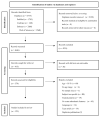Prevalence of Orthodontic Malocclusions in Healthy Children and Adolescents: A Systematic Review
- PMID: 35742703
- PMCID: PMC9223594
- DOI: 10.3390/ijerph19127446
Prevalence of Orthodontic Malocclusions in Healthy Children and Adolescents: A Systematic Review
Abstract
The purpose of this study was to systematically review the literature regarding the prevalence of malocclusion and different orthodontic features in children and adolescents.
Methods: The digital databases PubMed, Cochrane, Embase, Open Grey, and Web of Science were searched from inception to November 2021. Epidemiological studies, randomized controlled trials, clinical trials, and comparative studies involving subjects ≤ 18 years old and focusing on the prevalence of malocclusion and different orthodontic features were selected. Articles written in English, Dutch, French, German, Spanish, and Portuguese were included. Three authors independently assessed the eligibility, extracted the data from, and ascertained the quality of the studies. Since all of the included articles were non-randomized, the MINORS tool was used to score the risk of bias.
Results: The initial electronic database search identified a total of 6775 articles. After the removal of duplicates, 4646 articles were screened using the title and abstract. A total of 415 full-text articles were assessed, and 123 articles were finally included for qualitative analysis. The range of prevalence of Angle Class I, Class II, and Class III malocclusion was very large, with a mean prevalence of 51.9% (SD 20.7), 23.8% (SD 14.6), and 6.5% (SD 6.5), respectively. As for the prevalence of overjet, reversed overjet, overbite, and open bite, no means were calculated due to the large variation in the definitions, measurements, methodologies, and cut-off points among the studies. The prevalence of anterior crossbite, posterior crossbite, and crossbite with functional shift were 7.8% (SD 6.5), 9.0% (SD 7.34), and 12.2% (SD 7.8), respectively. The prevalence of hypodontia and hyperdontia were reported to be 6.8% (SD 4.2) and 1.8% (SD 1.3), respectively. For impacted teeth, ectopic eruption, and transposition, means of 4.9% (SD 3.7), 5.4% (SD 3.8), and 0.5% (SD 0.5) were found, respectively.
Conclusions: There is an urgent need to clearly define orthodontic features and malocclusion traits as well as to reach consensus on the protocols used to quantify them. The large variety in methodological approaches found in the literature makes the data regarding prevalence of malocclusion unreliable.
Keywords: adolescents; children; malocclusion; orthodontic features; prevalence.
Conflict of interest statement
The authors declare no conflict of interest.
Figures
References
-
- World Dental Federation From Strictly Aesthetics to an Integral Part of Oral Health: A Brief History of Orthodontics through the Ages. [(accessed on 2 June 2022)]. Available online: https://www.fdiworlddental.org/strictly-aesthetics-integral-part-oral-he....
-
- Carels C., De Ridder L., Van Loock N., Bogaerts K., Eyssen M., Obyn C. Orthodontics for Children and Adolescents. KCE Reports 77, Federaal Kenniscentrum Voor de Gezondheidszorg. [(accessed on 16 October 2021)];2008 Available online: https://kce.fgov.be/en/publication/report/orthodontics-for-children-and-....
-
- Hassan R., Ak R. Occlusion, malocclusion and method of measurements—An overview. Arch. Orofac. Sci. 2007;2:3–9.
-
- Proffit W.R., Fields H.W., Larson B., Sarver D.M. Contemporary Orthodontics-e-Book. Mosby; London, UK: 2018. p. 746.
Publication types
MeSH terms
LinkOut - more resources
Full Text Sources
Research Materials




